华南莲花山岩浆岩多期岩浆过程的地质年代和地球化学约束:岩石成因和多金属矿化的影响
IF 3.2
2区 地球科学
Q1 GEOLOGY
引用次数: 0
摘要
莲花山浴火岩是位于华南世界级巨型钨多金属矿带中段的复合岩体,蕴藏着超过5万吨的巨大钨储量。尽管莲花山浴火岩具有重要的经济意义,但其各期岩石成因及其与钨多金属矿化的时间和成因关系仍不清楚。针对这些问题,我们对莲花山浴成岩进行了全面研究,包括LA-ICP-MS锆石U-Pb定年、全岩地球化学和原位矿物微量元素分析。与以往研究不同的是,该研究确定了四个主要花岗岩相(G1-G4)。生物花岗岩(G1)形成于 168.6 至 165.3 Ma,硅含量最低,铝和铁含量较高,Ba、Sr、Ti、P 和 Nb 含量显著降低,而 U、Hf、Zr 和 Y 含量较高。相比之下,形成于 162.8 至 160.5 Ma 的双云母花岗岩(G2)和细粒蕈云母花岗岩(G3)表现出相似的特征,包括 La、Y、Hf、Th、U 的富集和 Ba、Sr、P 的贫化。其特征是 K、Si、Th、U、Zr、Hf 含量高,而 Al、Fe、Sr、P 和 Ti 含量低。这些特征支持了莲花山浴成岩的四个主要相属于S型花岗岩,经历了显著的分块结晶,并显示出还原和低温特征。结合之前发表的研究,我们认为莲花山浴成岩形成于古太平洋板块高角度回滚俯冲所引发的板内伸展环境中。早期的三个阶段(即 G1-G3)又具有较强的氧化性,是由锰矿化向钨矿化过渡的主要原因。相比之下,G4 花岗岩的特点是氧富集度较低,是铅-锌-镁-铀多金属矿化的主要成矿期。本文章由计算机程序翻译,如有差异,请以英文原文为准。

Geochronological and geochemical constraints on the multistage magmatic processes of the Lianhuashan batholith, South China: Implications for the petrogenesis and polymetallic mineralization
The Lianhuashan batholith, which is a composite pluton located in the middle part of a world-class giant tungsten (W) polymetallic belt of South China, hosts a huge reserve of more than 50,000 t of W. Despite this great economic significance, the petrogenesis of each phase of the Lianhuashan batholith, as well as its temporal and genetic relationships to the W polymetallic mineralization, is still unclear. To address these questions, we conducted a comprehensive study for the Lianhuashan batholith, including LA-ICP-MS zircon U-Pb dating, whole-rock geochemical and in-situ mineral trace element analyses. Different from previous studies, four main granitic phases (G1–G4) were identified. The biotite granite (G1) formed from 168.6 to 165.3 Ma, has the lowest Si content and high Al and Fe contents, and is significantly depleted in Ba, Sr, Ti, P, and Nb whereas enriched in U, Hf, Zr, and Y contents. In contrast, the two-mica granite (G2) and fine-grained muscovite granite (G3), which formed from 162.8 to 160.5 Ma, exhibit similar characteristics including enrichment in La, Y, Hf, Th, U, and depletion in Ba, Sr, and P. The porphyritic granite (G4) is the latest magmatic phase and formed at 158.3 Ma. It is characterized by high K, Si, Th, U, Zr, Hf contents but low Al, Fe, Sr, P, and Ti contents. These features support that four main phases of the Lianhuashan batholith belong to S-type granites that experienced significant fractional crystallization, and display reduced and low temperature features. Combined with previously published studies, we suggest that the Lianhuashan batholith formed in an intraplate extensional setting triggered by the high-angle rollback subduction of the paleo-Pacific plate. The three early phases (i.e., G1–G3) are in turn more oxidized and are responsible for the transition from Sn- to W-dominated mineralization. In contrast, the G4 granite, characterized by lower oxygen fugacity, is resposible for Pb-Zn-Ag-U polymetallic mineralization.
求助全文
通过发布文献求助,成功后即可免费获取论文全文。
去求助
来源期刊

Ore Geology Reviews
地学-地质学
CiteScore
6.50
自引率
27.30%
发文量
546
审稿时长
22.9 weeks
期刊介绍:
Ore Geology Reviews aims to familiarize all earth scientists with recent advances in a number of interconnected disciplines related to the study of, and search for, ore deposits. The reviews range from brief to longer contributions, but the journal preferentially publishes manuscripts that fill the niche between the commonly shorter journal articles and the comprehensive book coverages, and thus has a special appeal to many authors and readers.
 求助内容:
求助内容: 应助结果提醒方式:
应助结果提醒方式:


